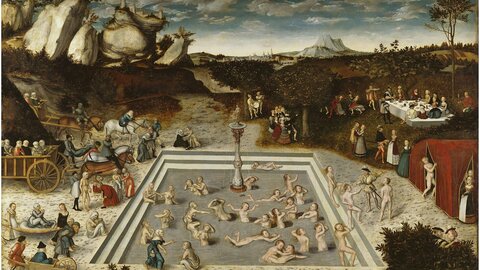Exploring the meaning of "Opfer"

The German term Opfer is a hypernym that can denote both “victim” (of a crime) and “sacrifice”. So what do German speakers think about when they hear the term Opfer? About someone being made a victim? Or about a sacrifice being made in order to achieve a goal? Especially among young people, the term is particularly complex: when waged at others, calling them a “victim”, it is an insult expressing contempt and disrespect, or it can be used without malice to define one’s own context or situation, perhaps even including claims for reparations.
Karin Peter from the Department of Practical Theology at the University of Vienna is investigating different interpretations of the German term, specifically in the context of school students. But actually, she has a bigger underlying concern: the question of whether and how the theory of “conceptual change” can be used in religious education. “Ultimately, it's about the question of how everyday definitions of a term relate to definitions specific to a certain subject matter,” says Peter. “But in order to study that, I first need to know if there is a difference between the two at all.” And this is what happens in the project “An Analysis on the Concept of Opfer in Religious Education”, which is funded by the Austrian Science Fund FWF.
From common to expert knowledge
In simplified terms, the theory of conceptual change is based on the assumption that students and other learners come to the classroom with existing ideas about a concept or phenomenon that are based on a common, non-technical understanding. The teacher's task is to change these individual notions and to trigger a conceptual change in the learner towards a subject-specific understanding. A shift from intuitive knowledge to expert knowledge, so to speak. “In our experience this concept works well in the STEM subjects,” says Peter.
In the natural sciences, there is usually a clear, vertical hierarchy: my everyday idea of the phenomenon of “force” does not necessarily help me with physics problems. In the worst case, it is even detrimental because it leads me down the wrong path in a subject-specific context. It has to be noted, however, that even in STEM subjects, complete conceptual change is usually not achieved: if someone uses “force” correctly in a physics class in the morning, they can still use it in the non-specific sense in the afternoon. “It is therefore important to understand such a conceptual change to apply in a horizontal sense as well,” notes Peter. “Different ideas can coexist on an equal footing and people can use them depending on the respective context.”
Study on the notion of Opfer among young people
The term Opfer lends itself well to research in a theological context because it can take so many different meanings, ranging from “victim” to “sacrifice”. In the course of an exploratory qualitative study Peter investigated which notion prevailed among the students. Exploratory qualitative research involves an open-ended approach, giving the participants as little guidance as possible. The researchers thus hope to obtain new insights or at least indications of which avenue is worth exploring further.
For the present study, 42 students in years 11 and 12 at four Austrian secondary academic schools answered a questionnaire in writing within the context of Catholic religious education. The questionnaire comprised two questions, both asking about the notion of Opfer. Semantic markers were used to place it in an everyday context in the first question and in a theological context in the second question. Semantic markers are terms or phrases that open up a certain context, such as family, friends or school for the students’ everyday world, or a reference to Jesus for a theological setting. Subsequently, the researcher evaluated the questionnaires with regard to whether and in what way everyday ideas are transformed into subject-specific theological ideas.
Theological intuition
“We were able to identify five transformation patterns in the responses,” says Peter. These were consistency (the motives and characteristics do not change or hardly change), narrower focus (individual motives or characteristics are dropped), adaptation (slight changes in motives or characteristics), figuration (fundamental changes in motives or characteristics) and reframing (introduction of aspects that were not previously an issue). “In terms of content, we were able to identify some commonalities in the transformation patterns,” says Peter. With the shift to the theological context, the students often emphasised the special nature and uniqueness of Jesus' sacrifice, which often reflected the beginnings of a subject-specific, theological conception. “In a way, the students show something like a ‘theological intuition’, but it requires deepening and differentiation.”
On this basis, teachers of religious studies may hope to be shown new and/or improved ways of familiarising young people with a world of ideas relevant for theology. Karin Peter's research is an important step on this path.
Personal details
Karin Peter studied theology and religious didactics in Innsbruck. While acquiring her doctorate she taught Catholic religion at a secondary school, and later at the Kirchliche Pädagogische Hochschule Edith Stein, a Catholic teacher training college, in Tyrol. Since 2014, she has been a postdoctoral researcher at the Department of Practical Theology at the University of Vienna, and since 2019, she has been the principal investigator of the Elise Richter project “An Analysis on the Concept of Opfer in Religious Education” (2019–2023), which is funded by the Austrian Science Fund FWF.
Publications
Peter K., Lehner-Hartmann A., Stockinger H.: Religion betrifft Schule. Religiöse Pluralität gestalten, in: Brennpunkt Schule, Kohlhammer 2022
Peter, Karin: Transformationsmuster juvenilen Theologisierens. Potential des conceptual change-Ansatzes für die Religionsdidaktik – exemplarisch im Kontext der Opferthematik, in: Theo-Web, 20(2), 176–181, 2021





